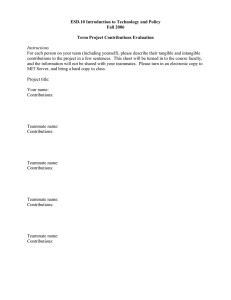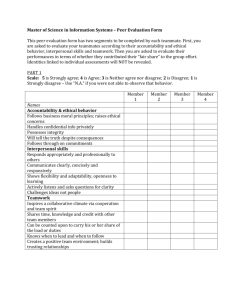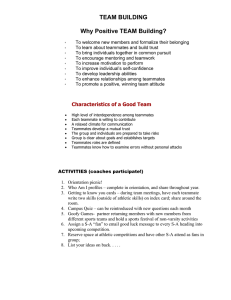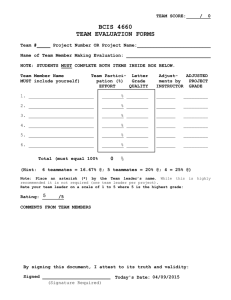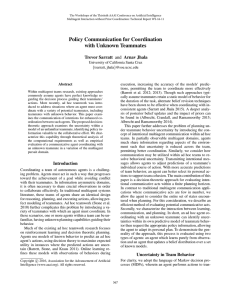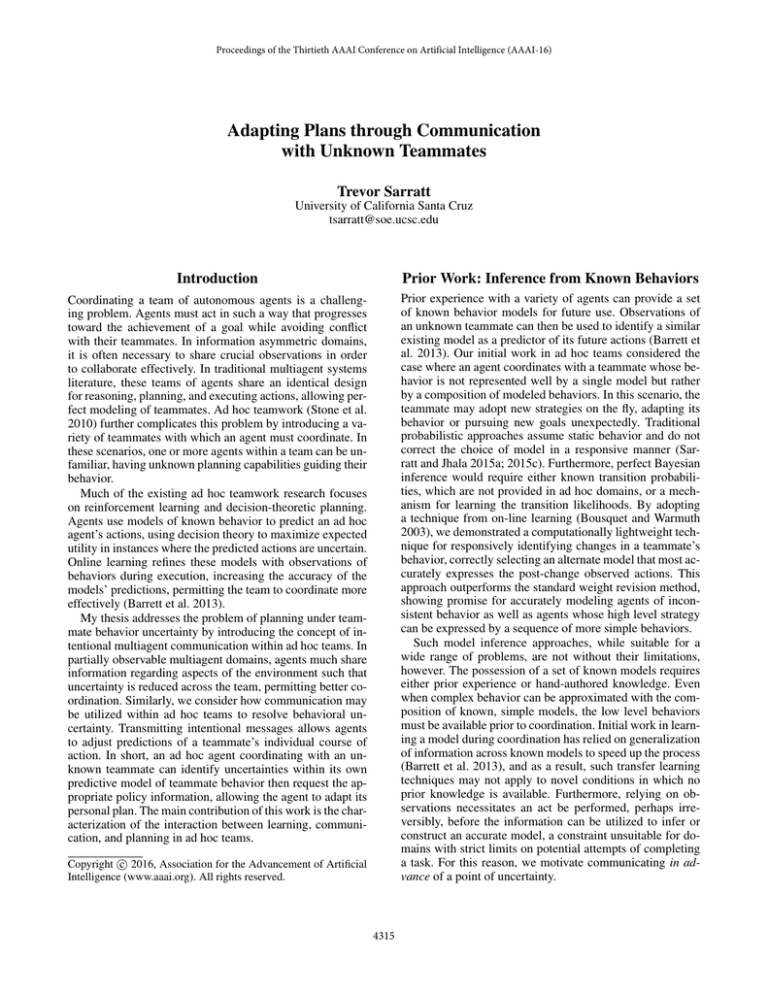
Proceedings of the Thirtieth AAAI Conference on Artificial Intelligence (AAAI-16)
Adapting Plans through Communication
with Unknown Teammates
Trevor Sarratt
University of California Santa Cruz
tsarratt@soe.ucsc.edu
Introduction
Prior Work: Inference from Known Behaviors
Coordinating a team of autonomous agents is a challenging problem. Agents must act in such a way that progresses
toward the achievement of a goal while avoiding conflict
with their teammates. In information asymmetric domains,
it is often necessary to share crucial observations in order
to collaborate effectively. In traditional multiagent systems
literature, these teams of agents share an identical design
for reasoning, planning, and executing actions, allowing perfect modeling of teammates. Ad hoc teamwork (Stone et al.
2010) further complicates this problem by introducing a variety of teammates with which an agent must coordinate. In
these scenarios, one or more agents within a team can be unfamiliar, having unknown planning capabilities guiding their
behavior.
Much of the existing ad hoc teamwork research focuses
on reinforcement learning and decision-theoretic planning.
Agents use models of known behavior to predict an ad hoc
agent’s actions, using decision theory to maximize expected
utility in instances where the predicted actions are uncertain.
Online learning refines these models with observations of
behaviors during execution, increasing the accuracy of the
models’ predictions, permitting the team to coordinate more
effectively (Barrett et al. 2013).
My thesis addresses the problem of planning under teammate behavior uncertainty by introducing the concept of intentional multiagent communication within ad hoc teams. In
partially observable multiagent domains, agents much share
information regarding aspects of the environment such that
uncertainty is reduced across the team, permitting better coordination. Similarly, we consider how communication may
be utilized within ad hoc teams to resolve behavioral uncertainty. Transmitting intentional messages allows agents
to adjust predictions of a teammate’s individual course of
action. In short, an ad hoc agent coordinating with an unknown teammate can identify uncertainties within its own
predictive model of teammate behavior then request the appropriate policy information, allowing the agent to adapt its
personal plan. The main contribution of this work is the characterization of the interaction between learning, communication, and planning in ad hoc teams.
Prior experience with a variety of agents can provide a set
of known behavior models for future use. Observations of
an unknown teammate can then be used to identify a similar
existing model as a predictor of its future actions (Barrett et
al. 2013). Our initial work in ad hoc teams considered the
case where an agent coordinates with a teammate whose behavior is not represented well by a single model but rather
by a composition of modeled behaviors. In this scenario, the
teammate may adopt new strategies on the fly, adapting its
behavior or pursuing new goals unexpectedly. Traditional
probabilistic approaches assume static behavior and do not
correct the choice of model in a responsive manner (Sarratt and Jhala 2015a; 2015c). Furthermore, perfect Bayesian
inference would require either known transition probabilities, which are not provided in ad hoc domains, or a mechanism for learning the transition likelihoods. By adopting
a technique from on-line learning (Bousquet and Warmuth
2003), we demonstrated a computationally lightweight technique for responsively identifying changes in a teammate’s
behavior, correctly selecting an alternate model that most accurately expresses the post-change observed actions. This
approach outperforms the standard weight revision method,
showing promise for accurately modeling agents of inconsistent behavior as well as agents whose high level strategy
can be expressed by a sequence of more simple behaviors.
Such model inference approaches, while suitable for a
wide range of problems, are not without their limitations,
however. The possession of a set of known models requires
either prior experience or hand-authored knowledge. Even
when complex behavior can be approximated with the composition of known, simple models, the low level behaviors
must be available prior to coordination. Initial work in learning a model during coordination has relied on generalization
of information across known models to speed up the process
(Barrett et al. 2013), and as a result, such transfer learning
techniques may not apply to novel conditions in which no
prior knowledge is available. Furthermore, relying on observations necessitates an act be performed, perhaps irreversibly, before the information can be utilized to infer or
construct an accurate model, a constraint unsuitable for domains with strict limits on potential attempts of completing
a task. For this reason, we motivate communicating in advance of a point of uncertainty.
c 2016, Association for the Advancement of Artificial
Copyright Intelligence (www.aaai.org). All rights reserved.
4315
Current Work: Communication
more, over the ensuing year, we intend to transition to a more
complex domain, using a slightly simplified form of the realtime strategy game, StarCraft.
An immediate extension to this work is the consideration of communicating multiple state-action pairs without
independent evaluation. It is possible for two states to have
no utility for communication individually but have non-zero
utility when considered together. This opens up a combinatorial space of potential intentional information sets that
could be communicated, similar to problem of picking a
subset of observations to share within a team, as explored
by Roth et al. 2006. Due to the intractable nature of the
problem, the authors motivated the exploration of heuristics as approximate solutions. It is yet unclear how states in
such collections will be related, though we hypothesize they
could take any one of various forms, including sequences of
successive states (forming a plan), areas of connected states
(a local subspace of the domain), or groups of independently
valuable states (such as branch points discussed earlier).
Across many communicative multiagent frameworks, such
as the COM-MTDP model (Pynadath and Tambe 2002) and
STEAM (Tambe 1997), communicative actions are often
limited to sharing observations. As agents in such systems
have complete information regarding the planning capacities
of their teammates, they can simply use the shared information to compute precisely how all agents will act. Since the
policies of teammates is the source of uncertainty in ad hoc
teams, it follows that policy information is a promising target for communicative acts. We introduced this idea in (Sarratt and Jhala 2015b).
In early decision-theoretic agent communication literature, various types of communication were theoretically validated in their effect on coordinating multiple agents. These
included intentional messages, questions, proposals, threats,
imperatives, and statements of propositional attitudes (Gmytrasiewicz, Durfee, and Rosenschein 1995). In each case,
providing or requesting information adjusted one or more
agents’ policies through refining an agent’s expectations of
either its own policy’s likelihood of success or the intentions
of another agent acting within the same environment. Analogously, the refinement of predicted action probabilities and,
consequently, an improved policy for a coordinating agent is
desirable for ad hoc teams.
Whereas the broadcast of the intention of pursuing a goal
addresses multiple state-action pairs within an agent’s policy computation, we must consider that an unfamiliar teammate may not possess the capability of reasoning with high
level abstractions such as joint plans or hierarchical goal decompositions. However, we put forth the observation that all
agents involved are universally tasked with assigning actions
to states, independent of the particular planning implementation details. From a general perspective, we consider how
an ad hoc agent could benefit from obtaining a single stateaction pair—the atomic component of a teammate model—
from communication.
In our submission to AAMAS-16 (Sarratt and Jhala Pending), we provided an efficient procedure for evaluating potential state-action pairs for communication by examining
the uncertainty within a teammate model as well as empirically analyzed various aspects of the communicative capability. For our test domain, we used a variation of the multiagent pursuit domain where two agents attempt to capture a prey within a maze. We were able to show the tradeoff between collected information and communication rates
and, likewise, the effect of communication costs on query
rates and the resulting expected utility of the agent. Finally,
our analysis determined that branch points in a maze are
commonly communicated more frequently than neighboring
cells, indicating that the tested agents determined resolving
uncertainty at such states was associated with higher utility.
References
Barrett, S.; Stone, P.; Kraus, S.; and Rosenfeld, A. 2013.
Teamwork with limited knowledge of teammates. In AAAI.
Bousquet, O., and Warmuth, M. K. 2003. Tracking a small
set of experts by mixing past posteriors. The Journal of Machine Learning Research 3:363–396.
Gmytrasiewicz, P. J.; Durfee, E. H.; and Rosenschein, J.
1995. Toward rational communicative behavior. In AAAI
Fall Symposium on Embodied Language, 35–43.
Pynadath, D. V., and Tambe, M. 2002. The communicative multiagent team decision problem: Analyzing teamwork
theories and models. Journal of Artificial Intelligence Research 389–423.
Roth, M.; Simmons, R.; and Veloso, M. 2006. What to communicate? execution-time decision in multi-agent pomdps.
In Distributed Autonomous Robotic Systems 7. Springer.
177–186.
Sarratt, T., and Jhala, A. 2015a. Rapid: A belief convergence strategy for collaborating with inconsistent agents. In
Workshops at the Twenty-Ninth AAAI Conference on Artificial Intelligence.
Sarratt, T., and Jhala, A. 2015b. The role of models and communication in the ad hoc multiagent team decision problem.
In Proceedings of the Third Annual Conference on Advances
in Cognitive Systems Poster Collection, 27.
Sarratt, T., and Jhala, A. 2015c. Tuning belief revision
for coordination with inconsistent teammates. In Eleventh
Artificial Intelligence and Interactive Digital Entertainment
Conference.
Sarratt, T., and Jhala, A. Pending. Communicating intentions for coordination with unknown teammates. In Thirtieth
AAAI Conference on Artificial Intelligence.
Stone, P.; Kaminka, G. A.; Kraus, S.; Rosenschein, J. S.;
et al. 2010. Ad hoc autonomous agent teams: Collaboration
without pre-coordination. In AAAI.
Tambe, M. 1997. Agent architectures for flexible. In Proc.
of the 14th National Conf. on AI, USA: AAAI press, 22–28.
Future Work
While our previous work has focused on the ability to coordinate with computer agents, we intend to test our approach
with human teammates, given the potential applicability of
ad hoc team approaches to human-computer teams. Further-
4316

